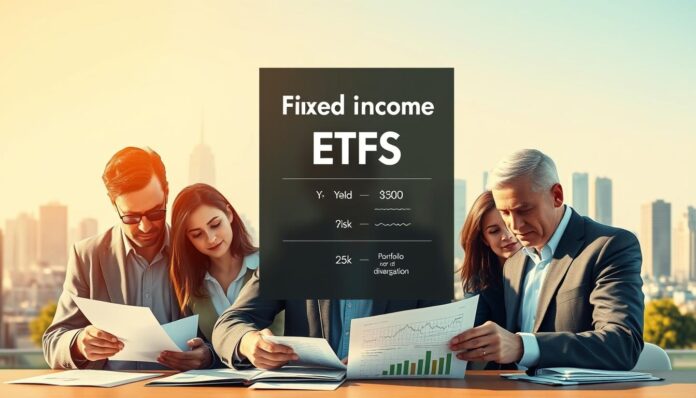What Are Fixed Income ETFs? These investment vehicles, known as fixed income ETFs, provide investors with access to bond markets through an exchange-traded structure. Like mutual funds, they pool money from multiple investors to buy a diversified portfolio of bonds or other fixed-income securities, but they trade on stock exchanges throughout the day like individual stocks.
Fixed Income ETFs Explained simply, they offer a flexible and cost-effective way to gain exposure to interest-paying assets while managing risk in changing economic conditions. Their popularity has surged as investors seek stable returns and diversification without the complexity of buying bonds individually.
Key Takeaways
- Fixed income ETFs track bonds or debt securities and trade on stock exchanges.
- They combine the diversification of mutual funds with the trading flexibility of stocks.
- These ETFs provide steady income streams from interest payments on underlying bonds.
- Cost efficiency makes them accessible for both new and experienced investors.
- They help reduce risk by spreading investments across various bonds.
Understanding Fixed Income ETFs
Fixed Income ETFs Explained can help investors navigate the bond market with simplicity. These investment tools pool money to buy diverse debt securities, offering accessibility to assets that might otherwise be complex to manage individually.
Definition of Fixed Income ETFs
Fixed income ETFs are investment funds trading on exchanges like stocks. They hold securities such as Treasury bonds, corporate notes, or municipal debt. Unlike single-bond purchases, these ETFs provide exposure to multiple issuers and maturities in one trade. For example, a single ETF might track the performance of the Bloomberg Aggregate Bond Index, holding hundreds of bonds from governments and corporations.
How They Work
How do Fixed Income ETFs Work? Here’s a breakdown:
- Creation/Redemption: Large institutions exchange baskets of underlying bonds for ETF shares, maintaining price alignment with net asset value.
- Index Tracking: Most ETFs follow bond indices, adjusting holdings to mirror index changes automatically.
- Trading: Traded like stocks, investors buy/sell shares throughout market hours at real-time prices.
These features let investors access broad bond exposure with transparency and flexibility, contrasting with traditional bond investing’s higher costs and limited liquidity. By pooling resources, Fixed Income ETFs Explained become a modern tool for steady income and portfolio diversification.
The Benefits of Fixed Income ETFs
Investors often ask What Are Fixed Income ETFs, but their Benefits of Fixed Income ETFs make them stand out. These funds combine simplicity and strategy, offering three clear advantages: diversification, liquidity, and cost savings.
Fixed Income ETFs spread risk across hundreds of bonds in a single purchase. For example, one fund might hold government, corporate, and municipal bonds. This reduces exposure to single-issuer risk, which is hard to match when buying individual bonds.
- Hold 100+ bonds with one trade
- Reduce reliance on any single company or sector
- Lower risk compared to picking individual bonds
These ETFs trade on exchanges like stocks, letting investors buy or sell shares instantly. This contrasts sharply with the traditional bond market, where trades can take days and prices are hard to compare. Key points:
- Trade anytime during market hours
- Transparent pricing updates in real time
- Avoid the slow process of OTC markets
Expense ratios for Fixed Income ETFs often beat bond mutual funds by half or more. Plus, no markups or transaction fees common in individual bond deals. Cost benefits include:
- Lower management fees than mutual funds
- No hidden fees for buying/selling shares
- Scale economies reduce per-bond costs
For conservative investors, diversification cuts risk best. Active traders might value liquidity. All investors save with lower costs. These strengths make Fixed Income ETFs a versatile tool for modern portfolios.
Types of Fixed Income ETFs
Fixed Income ETFs Explained often start by categorizing them based on the bonds they hold. Investors can choose from three main types, each tailored to different goals and risk tolerances.
Government Bond ETFs
Government Bond ETFs focus on debt issued or guaranteed by governments. These include U.S. Treasury securities, known for minimal credit risk. For example, the iShares 7-10 Year Treasury Bond ETF (IEF) tracks intermediate-term Treasuries, offering stability. These are ideal for risk-averse investors seeking principal protection.
Corporate Bond ETFs
Corporate Bond ETFs invest in debt from companies, ranging from investment-grade to high-yield bonds. The AGG (iShares Core U.S. Aggregate Bond ETF) covers a broad spectrum of corporate issuers. While higher yields attract investors, they carry more default risk compared to government options.
Municipal Bond ETFs
Municipal Bond ETFs, like the MUB (iShares National Muni Bond ETF), invest in bonds issued by states and local governments. Their key advantage is tax-exempt interest income, making them popular in high-tax states. However, liquidity can vary between issues.
| Type | Risk Profile | Popular ETFs |
|---|---|---|
| Government | Low credit risk | SHY, TLT, IEF |
| Corporate | Varies by credit rating | AGG, HYG, LQD |
| Municipal | Low default risk | MUB, TFLO, MUFL |
Top Fixed Income ETFs in each category offer distinct benefits. Investors should evaluate their tax situation and risk tolerance when selecting these options.
How to Invest in Fixed Income ETFs
Starting with Investing in Fixed Income ETFs requires clear steps to match your financial goals. Begin by researching Top Fixed Income ETFs that align with your risk tolerance and time horizon.
Choosing the Right ETF
- Compare expense ratios to minimize costs.
- Check tracking accuracy against their benchmark index.
- Review the ETF’s duration and credit quality to match your strategy.
- Focus on funds with high liquidity to ensure smooth trading.
Opening a Brokerage Account
Choose a brokerage platform like Fidelity, Charles Schwab, or Vanguard. Compare their fee structures, research tools, and trading commissions. Most platforms offer paper trading tools for practice before live trades. Always verify the ETF’s prospectus and historical performance data before investing.
Comparing Fixed Income ETFs and Mutual Funds
When choosing between Fixed Income ETFs and mutual funds, understanding their differences can shape your investment strategy. Here’s a clear breakdown of how they stack up.
Key Differences
- Trading Times: ETFs trade like stocks throughout the day, while mutual funds price only once daily at NAV.
- Costs: ETFs often have lower expense ratios compared to many mutual funds.
- Transparency: ETFs reveal holdings daily; mutual funds may lag in disclosure frequency.
Advantages of ETFs Over Mutual Funds
Investing in Fixed Income ETFs offers these perks:
- Lower Fees: Lower expense ratios save money over time.
- Tax Efficiency: ETFs’ creation/redemption process reduces taxable distributions.
- Liquidity: Trade anytime the market is open, unlike mutual funds.
Mutual funds still suit some investors, especially for specialized strategies or retirement accounts. But for most, Fixed Income ETFs offer modern, cost-effective tools for building a portfolio.
Risks Associated with Fixed Income ETFs
While Fixed Income ETFs provide stability, they carry risks that require careful consideration. Understanding these risks helps investors align their strategy with market trends like the Fixed Income ETFs Market Trends
Interest Rate Risk
Rising interest rates lower bond prices. Long-term bonds in ETFs face bigger drops. Duration—a measure of price sensitivity—guides how much values might shift. Current trends show prolonged high rates could pressure returns.
Credit Risk
Issuers might fail to pay interest or principal. ETFs holding corporate or high-yield bonds face higher defaults. Credit ratings (like BBB or below) signal risk levels, but diversification limits exposure.
Other risks include:
- Liquidity challenges during market stress
- Tracking errors vs. benchmarks
- Premium/discount swings vs net asset value
| Risk Type | Description |
|---|---|
| Interest Rate | Prices fall when rates rise |
| Credit | Risk of issuer default |
| Liquidity | Harder to sell ETFs quickly |
Monitoring these factors alongside Fixed Income ETFs Market Trends helps balance risk and reward. Regular portfolio reviews ensure strategies adapt to changing conditions.
Tax Implications of Investing in Fixed Income ETFs
Managing taxes is key when Investing in Fixed Income ETFs. These investments come with unique rules that impact your returns. Let’s break down how taxes apply to interest and capital gains.
Tax Treatment of Interest Income
Interest from Fixed Income ETFs counts as ordinary income, taxed at your marginal rate. Different bond types have varied treatment:
| Bond Type | Federal Tax | State Tax |
|---|---|---|
| Treasury Bonds | Fed taxable | No state exemption |
| Corporate Bonds | Fed and state taxable | No exemption |
| Municipal Bonds | Fed exempt | Exempt in issuer’s state |
Municipal bonds offer tax breaks, making them ideal for taxable accounts. High-yield bonds may face higher taxes. Always review your portfolio’s tax profile.
Capital Gains Considerations
Capital gains arise from price changes or sales. Fixed Income ETFs often distribute less capital gains than mutual funds due to their structure. However, tax advantages are smaller compared to equity ETFs. Strategies like tax-loss harvesting can offset gains, but consult a pro before acting.
- Short-term gains (held <1 year) taxed as ordinary income
- Long-term gains taxed at lower capital gains rates
- ETFs minimize embedded capital gains vs. mutual funds
Always prioritize tax-smart placement. Municipal bonds in taxable accounts, taxable bonds in IRAs. Benefits of Fixed Income ETFs include liquidity and diversification—but taxes demand careful planning.
Performance: What to Expect from Fixed Income ETFs
Fixed Income ETFs Performance Analysis requires understanding how returns shift with market cycles. Recent data shows yields and price movements vary widely depending on economic conditions. Fixed Income ETFs Market Trends also highlight how external factors like interest rates shape outcomes.
Historical Returns Analysis
Past performance reveals distinct patterns:
- Government bond ETFs often rise when rates fall, but drop when rates climb.
- Corporate bond ETFs balance credit risk with higher yields compared to Treasuries.
- Municipal bond ETFs historically offer tax-free income but depend on local economic health.
Market Conditions Affecting Performance
Today’s investors should monitor these factors:
- Interest Rate Policies: Fed rate cuts boost bond prices, while hikes pressure them downward.
- Inflation Levels: Rising inflation can erode fixed income purchasing power unless hedged.
- Economic Growth: Expanding economies may favor corporate bonds; recessions favor safer government bonds.
Current conditions show low interest rates creating uncertain environments. Investors should analyze Fixed Income ETFs Market Trends to align with personal risk tolerance. Remember: past performance does not guarantee future results.
Strategies for Investing in Fixed Income ETFs

Building a strong fixed income portfolio requires more than just buying shares. Smart strategies can help investors balance risk and returns. Let’s explore proven methods to optimize your Fixed Income ETFs holdings.
Laddering Strategy
Instead of locking funds in long-term bonds, a laddering approach uses ETFs with staggered maturities. For example, investing in short-term, intermediate, and long-term ETFs creates a balanced income stream. This strategy reduces interest rate risk and keeps capital accessible. Unlike individual bonds, ETFs offer instant diversification, making ladders easier to build. Consider Fixed Income ETFs vs. Bonds here: ETFs provide liquidity without the hassle of tracking dozens of individual bonds.
Active vs. Passive Management
Passive ETFs track indexes like the Bloomberg Aggregate, offering low costs and steady returns. Active managers, however, aim to outperform by selecting bonds or adjusting durations. The table below compares their pros and cons:
| Factor | Active Management | Passive Management |
|---|---|---|
| Cost | Higher fees | Lower expense ratios |
| Risk | Potential for higher returns but with variability | Predictable returns aligned with benchmarks |
| Use Case | Targeting inefficiencies in niche markets | Core portfolio diversification |
“Diversification is key—mix active and passive approaches based on your goals,” says the 2023 Morningstar Fixed Income Report.
Other techniques include:
- Core-satellite setups: Use passive ETFs as core holdings with tactical active picks
- Barbell strategies: Pair short-term and long-term ETFs to capitalize on yield curves
Every investor’s path differs. Start small with a laddered core, then adapt using these strategies. Remember: Investing in Fixed Income ETFs is about flexibility, not rigid rules.
FAQs About Fixed Income ETFs
Still curious about fixed income ETFs? Let’s address key questions and clear up any confusion.
What Investors Should Know
Learning how fixed income ETFs work starts with distributions. These funds pay out interest from underlying bonds regularly, often monthly. When rates rise, longer-duration ETFs may drop more in value than shorter-term ones. Metrics like weighted average maturity and yield to maturity help gauge risks and returns. Always align these details with your goals, like income or capital preservation.
Common Misconceptions
Fixed income ETFs performance analysis shows their prices don’t always mirror interest rate changes instantly. Liquidity isn’t tied to the bonds they hold but their trading volume on exchanges. While safer than stocks, they’re not risk-free—credit quality and market shifts still matter. Remember, no investment is 100% safe, even in bonds.

